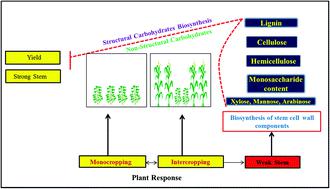当前位置:
X-MOL 学术
›
Photochem. Photobiol. Sci.
›
论文详情
Our official English website, www.x-mol.net, welcomes your feedback! (Note: you will need to create a separate account there.)
Effects of lignin, cellulose, hemicellulose, sucrose and monosaccharide carbohydrates on soybean physical stem strength and yield in intercropping
Photochemical & Photobiological Sciences ( IF 3.1 ) Pub Date : 2020-02-24 , DOI: 10.1039/c9pp00369j Sajad Hussain 1, 2, 3, 4, 5 , Ting Liu 1, 2, 3, 4, 5 , Nasir Iqbal 6, 7, 8, 9, 10 , Marian Brestic 11, 12, 13, 14, 15 , Ting Pang 1, 2, 3, 4, 5 , Maryam Mumtaz 1, 2, 3, 4 , Iram Shafiq 1, 2, 3, 4, 5 , Shuxian Li 1, 2, 3, 4, 5 , Li Wang 1, 2, 3, 4, 5 , Yang Gao 1, 2, 3, 4, 5 , Aaqil Khan 1, 2, 3, 4, 5 , Irshan Ahmad 1, 2, 3, 4, 5 , Suleyman I. Allakhverdiev 16, 17, 18, 19, 20 , Weiguo Liu 1, 2, 3, 4, 5 , Wenyu Yang 1, 2, 3, 4, 5
Photochemical & Photobiological Sciences ( IF 3.1 ) Pub Date : 2020-02-24 , DOI: 10.1039/c9pp00369j Sajad Hussain 1, 2, 3, 4, 5 , Ting Liu 1, 2, 3, 4, 5 , Nasir Iqbal 6, 7, 8, 9, 10 , Marian Brestic 11, 12, 13, 14, 15 , Ting Pang 1, 2, 3, 4, 5 , Maryam Mumtaz 1, 2, 3, 4 , Iram Shafiq 1, 2, 3, 4, 5 , Shuxian Li 1, 2, 3, 4, 5 , Li Wang 1, 2, 3, 4, 5 , Yang Gao 1, 2, 3, 4, 5 , Aaqil Khan 1, 2, 3, 4, 5 , Irshan Ahmad 1, 2, 3, 4, 5 , Suleyman I. Allakhverdiev 16, 17, 18, 19, 20 , Weiguo Liu 1, 2, 3, 4, 5 , Wenyu Yang 1, 2, 3, 4, 5
Affiliation

|
Soybean (Glycine max L.) has been extensively cultivated in maize–soybean relay intercropping systems in southwest China. However, during the early co-growth period, soybean seedlings suffer from severe shading by maize resulting in lodging and significant yield reduction. The purpose of the present research was to investigate the reasons behind severe lodging and yield loss. Therefore, four different soybean genotypes (B3, B15, B23, and B24) having different agronomic characteristics were cultivated in intercropping and monocropping planting patterns. The results showed that under different planting patterns, the stem resistance varied among genotypes (P < 0.01). The lodging resistance index of B3, B15, B23, and B24 genotypes was 70.9%, 60.5%, 65.2%, and 57.4%, respectively, under intercropping, among which the B24 genotype was less affected by the shade environment as there was little decrease in the lodging resistance index of this genotype under intercropping. The lignin content of B23 and B24 was significantly higher than that of B3 and B15 under both planting patterns. Under intercropping, the hemicellulose content of B23 and B24 stems was significantly higher than that of B3 and B15. Compared to the monocropping, the content of mannose in the structural carbohydrate of soybean stems was decreased in all genotypes except B23, but the difference was not significant. The content of xylose in the structural carbohydrate of soybean stems was significantly higher than that in B3 and B15. Mannose content showed no significant difference among genotypes. The arabinose content of B24 was significantly higher than that of B3, B15, and B23. The effective pod number, seed number per plant, seed weight per plant and yield of soybean plants were significantly decreased under intercropping. Conclusively, manipulation of structural and nonstructural carbohydrate rich soybean genotypes in intercropping systems could alleviate the yield loss due to lodging.
更新日期:2020-02-24


























 京公网安备 11010802027423号
京公网安备 11010802027423号